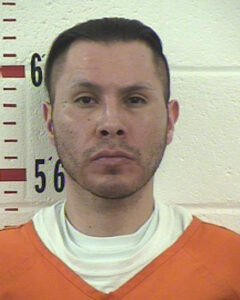• Eric Garcia said he stabbed R.L. repeatedly with a knife during an interrogation
• His attorney wrote he has the mindset and cognitive ability of a 5-year-old child
• FBI Agent Mark Spencer made no mention of Garcia’s diminished mental capacity when describing his interrogation
See the case write-up
SMITH LAKE, N.M. — A Smith Lake man’s murder case is on pause after his attorney raised competency and wrote his client has the cognitive ability of a 5-year-old child.
FBI Agent Mark Spencer charged Eric Garcia, 40, with an open count of murder for the stabbing death of a man identified as R.L. in court documents, on March 9, 2021.
One day after Garcia’s initial appearance on March 15, 2021, and Magistrate Judge Jerry Ritter ordered him held without bail pending a detention hearing, his attorney, Lucas Babycos, filed a motion for Garcia to be evaluated for his competency.
“Counsel has reason to believe that the defendant has been formally diagnosed with a severe form of intellectual disability,” Babycos wrote.
He wrote that Garcia has the mindset and cognitive abilities of a 5-year-old child and that he cannot effectively consult with him, nor can Garcia assist in his own defense.
“Defendant has no concept of what is occurring, or the magnitude of the allegations brought forward against him,” Babycos wrote.
Babycos and prosecutor Allison Jaros agreed to a competency evaluation by Julie Brovko or that he be sent to the Bureau of Prisons for an evaluation, he wrote.
Magistrate Judge Laura Fashing granted the motion the same day, according to the docket.
The next day, March 17, Fashing held a hearing on the case and Babycos told her he had “concerns” with Garcia remaining “at facility,” according to the minutes. Fashing ordered the case be stayed until the competency evaluation is complete.
No further court hearings are set.
The stabbing
Garcia stabbed R.L. repeatedly with a knife on March 9 after being told to leave R.L.’s house, after R.L. grabbed him.
Navajo Police Department officers initially received a call at 12:44 a.m., March 9, 2021. for a person laying on the floor of a house in Smith Lake, bleeding, Spencer wrote in an affidavit for a criminal complaint.
When officers arrived, they found R.L., YOB 1957, bleeding from the chest, abdomen and neck. Paramedics declared him dead 35 minutes later, at 1:19 a.m, Spencer wrote.

A woman identified by the initials P.E., and referred to as Witness 1, told investigators she, R.L. and Garcia had been drinking inside the house. R.L. asked Garcia to leave “and a conflict happened.” Garcia had a knife and stabbed John Doe. P.E. ran outside, ran into another woman identified as M.L. and told her to call the police, he wrote.
M.L. told investigators she heard noises and went outside. P.E. told her to call the police. She went to the house and saw Garcia standing over R.L., left, told another family member what happened and then called the police, Spencer wrote.
Navajo police learned that Garcia lived a half-mile away, across the main road and knocked on his door, he wrote.
“GARCIA opened the door and had what appeared to be blood his hands, pants, and boots,” Spencer wrote. “GARCIA was taken into custody by NPD.”
FBI agents contacted a magistrate judge for an oral search warrant and found a bloody knife in a search of his house, he wrote.
FBI and Navajo Nation Police officers interrogated Garcia at the Crownpoint Police Department after Garcia waived his Miranda rights, Spencer wrote.
Spencer made no mention in his affidavit if it seems like Garcia has any cognitive issues, or the mindset of a 5-year-old child.
Defendants must “knowingly and intelligently” waive their Miranda rights, including the rights to remain silent and right to counsel.
In Garner v. Mitchell, a 2007 appeal in the Sixth Circuit Court of Appeals, the court found that “petitioner’s waiver of his Miranda rights was invalid because testing demonstrated that the petitioner’s mental incapacity rendered him unable to fully comprehend the warnings and his right to remain silent.”
Spencer wrote that Garcia said he was drinking with R.L. and P.E. outside by the trees, and then moved into the house. Garcia helped to make dinner and R.L. gave him a knife to peel the potatoes. At some point, R.L. told him to leave and Garcia did not want to, he continued to tell him to leave and they started yelling at each other.
“John Doe grabbed GARCIA’s arms and tried to get him out of the house,” Spencer wrote. “GARCIA had the knife from peeling the potatoes in his pocket and pulled it out and stabbed John Doe in the chest area. The next stab was to the neck and then continued stabbing John Doe in the chest and back. GARCIA left and went home.”
View the case files on Document Cloud, Google Drive or Court Listener.
Continue reading “Competency raised for Smith Lake man with mindset of a 5-year-old child”




